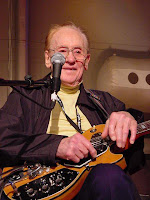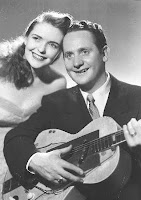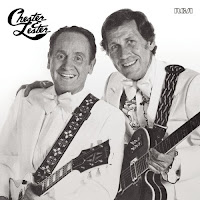Les Paul (1915 - 2009)
I was very saddened today to learn that one of the truly great men in the history of modern music passed away, Les Paul. The music of the last 50 years would have been very differnt without his innovations in guitar design and recording. This is the salute I wrote to him on Vintage Vinyl News.
----------------------------------------------------

The world has lost one of the greatest guitarists and innovators of the last 75 years with the passing of Les Paul. Not only did he have 14 number one records, but he's also the man behind the solid body electric guitar, multitrack recording, overdubbing, delay, phasing and many more innovations. Paul passed away earlier today (Thursday) of complications from pneumonia. He was 94.
Les Paul was born on June 9, 1915 in Waukesha, Wisconsin where he picked up on a variety of musical intstruments (harmonica, piano, banjo) at an early age before settling on the guitar. Les started playing in public at the age of 13 and, by 17, he had quit school and was playing in Sunny Joe Wolverton's Radio Band that was based in St. Louis.
Paul was well versed in a variety of styles, playing "hillbilly" guitar under the name of Rhubarb Red while also playing jazz in other locations under his own name. He recorded in the mid-30's under the Red moniker along with backing up musicians like blues singer Georgia White.
In 1938, Paul moved to New York where he began playing on national radio in Fred Waring's Pennsylvanians. It was during that time that he started experimenting with building his first electric guitar, opting to experiment with a solid body instead of the early hollow body models on the market.
His constant experimenting was interrupted in 1940 when he electrocuted himself while working at his home. Paul underwent two years of rehabilitation followed by a stint in the U.S. Army where he played and recorded for Armed Forces Radio.
Post-military, Paul formed a new trio and perfected his mix of jazz and western swing, recording for Decca and as featured performers with many of the label's vocalists, including Bing Crosby who regularly had the group on his radio show. The exposure led to Paul's first number one, It's Been a Long, Long Time.
Never one to just languish with fame, Paul began experimenting with overdubbing which eventually led to his Lover (When You're Near Me), a record that featured the guitarist playing simultaneously on eight different parts. Shortly after the record's release, Paul would almost lose his life for a second time in a decade when he was involved in a serious car accident that nearly destroyed his right arm and elbow. It took some serious persuading, but he was able to convince the doctors to permanently set his arm in a position that would allow him to continue to cradle and play his instrument.

While recuperating from the accident, Les began his work on adding a fourth head to a reel-to-reel tape recorder, an innovation that would lead to multi-track recording along with tape delay. By the start of the new decade, Paul was ready to apply all that he learned and recorded How High the Moon with wife Mary Ford. The record shot to number one and stayed there for nine weeks in mid-1951. The pair also topped the charts for eleven more weeks in 1953 with Vaya Con Dios and had top ten records with the likes of Tennessee Waltz, Mockin' Bird Hill, Bye Bye Blues and I'm Sitting On Top of the World.
It was also during the late-40's and early-50's that Gibson guitar worked with Paul to develop the ultimate solid body electric guitar. Les was never satisfied with the sound of the hollow body models, saying he wanted a way to pick up the pure sound of the strings without any vibration from the wood. It all came together in 1952 with the release of the original Les Paul Goldtop which would set the standard for solid body electric guitars for years to come.

Les Paul and Mary Ford's hits became less frequent as rock music became the norm; however, they continued to do their weekly television show which aired from 1953 until the latter part of the decade. The pair divorced in 1964 and Les fell out of the public eye in the U.S., preferring to play in Japan.

From the late-60's on, Paul had numerous run-ins with poor health, forcing him to take time off from his musical pursuits. He returned to recording in 1977, winning a Grammy Award for his collaboration with Chet Atkins, Chester and Lester. His health caught up with him again later in the year when he suffered a heart attack and had to undergo bypass surgery.
Over the next three decades, despite arthritis, hearing loss and other ailments, Les Paul has continued to entertain. In 2005, he won two Grammys for his album Les Paul & Friends: American Made World Played which was recorded with artists like Buddy Guy, Eric Clapton and Joe Perry. Since 1984, Les has played weekly shows in New York, first at Fat Tuesday's and, starting in 1996, at the Iridium Jazz Club. His last appearance at the club was in June.
Les Paul is the only person to be elected to the Rock and Roll Hall of Fame, the Grammy Hall of Fame, the National Inventors Hall of Fame and the National Broadcasters Hall of Fame.
Terry Stewart, president and CEO of the Rock and Roll Hall of Fame, said “Without Les Paul, we would not have rock and roll as we know it. His inventions created the infrastructure for the music and his playing style will ripple through generations. He was truly an architect of rock and roll.”
Hall of Fame vice president Jim Henke added “Les Paul was truly a unique human being. He was an artist who made his mark as a tremendously influential guitarist. He was also an inventor, the man responsible for the solid-body electric guitar and multi-track recording. Few people have accomplished as much as Les did in his legendary career. We will truly miss him.”
Finally, Henry Juszkiewicz, President and CEO of Gibson Guitars, issued the statement, "The world has lost a truly innovative and exceptional human being today. I cannot imagine life without Les Paul. He would walk into a room and put a smile on anyone's face. His musical charm was extraordinary and his techniques unmatched anywhere in the world."
A few memories of Les Paul:
Les Paul and Mary Ford talk about multitracking and perform the classic How High the Moon.
A great video from early-50's TV that not only shows Paul's guitar talent, but also that Ford was no slouch, either.
A later recording with Jeff Beck and Billy Squire.
----------------------------------------------------

The world has lost one of the greatest guitarists and innovators of the last 75 years with the passing of Les Paul. Not only did he have 14 number one records, but he's also the man behind the solid body electric guitar, multitrack recording, overdubbing, delay, phasing and many more innovations. Paul passed away earlier today (Thursday) of complications from pneumonia. He was 94.
Les Paul was born on June 9, 1915 in Waukesha, Wisconsin where he picked up on a variety of musical intstruments (harmonica, piano, banjo) at an early age before settling on the guitar. Les started playing in public at the age of 13 and, by 17, he had quit school and was playing in Sunny Joe Wolverton's Radio Band that was based in St. Louis.
Paul was well versed in a variety of styles, playing "hillbilly" guitar under the name of Rhubarb Red while also playing jazz in other locations under his own name. He recorded in the mid-30's under the Red moniker along with backing up musicians like blues singer Georgia White.
In 1938, Paul moved to New York where he began playing on national radio in Fred Waring's Pennsylvanians. It was during that time that he started experimenting with building his first electric guitar, opting to experiment with a solid body instead of the early hollow body models on the market.
His constant experimenting was interrupted in 1940 when he electrocuted himself while working at his home. Paul underwent two years of rehabilitation followed by a stint in the U.S. Army where he played and recorded for Armed Forces Radio.
Post-military, Paul formed a new trio and perfected his mix of jazz and western swing, recording for Decca and as featured performers with many of the label's vocalists, including Bing Crosby who regularly had the group on his radio show. The exposure led to Paul's first number one, It's Been a Long, Long Time.
Never one to just languish with fame, Paul began experimenting with overdubbing which eventually led to his Lover (When You're Near Me), a record that featured the guitarist playing simultaneously on eight different parts. Shortly after the record's release, Paul would almost lose his life for a second time in a decade when he was involved in a serious car accident that nearly destroyed his right arm and elbow. It took some serious persuading, but he was able to convince the doctors to permanently set his arm in a position that would allow him to continue to cradle and play his instrument.

While recuperating from the accident, Les began his work on adding a fourth head to a reel-to-reel tape recorder, an innovation that would lead to multi-track recording along with tape delay. By the start of the new decade, Paul was ready to apply all that he learned and recorded How High the Moon with wife Mary Ford. The record shot to number one and stayed there for nine weeks in mid-1951. The pair also topped the charts for eleven more weeks in 1953 with Vaya Con Dios and had top ten records with the likes of Tennessee Waltz, Mockin' Bird Hill, Bye Bye Blues and I'm Sitting On Top of the World.
It was also during the late-40's and early-50's that Gibson guitar worked with Paul to develop the ultimate solid body electric guitar. Les was never satisfied with the sound of the hollow body models, saying he wanted a way to pick up the pure sound of the strings without any vibration from the wood. It all came together in 1952 with the release of the original Les Paul Goldtop which would set the standard for solid body electric guitars for years to come.

Les Paul and Mary Ford's hits became less frequent as rock music became the norm; however, they continued to do their weekly television show which aired from 1953 until the latter part of the decade. The pair divorced in 1964 and Les fell out of the public eye in the U.S., preferring to play in Japan.

From the late-60's on, Paul had numerous run-ins with poor health, forcing him to take time off from his musical pursuits. He returned to recording in 1977, winning a Grammy Award for his collaboration with Chet Atkins, Chester and Lester. His health caught up with him again later in the year when he suffered a heart attack and had to undergo bypass surgery.
Over the next three decades, despite arthritis, hearing loss and other ailments, Les Paul has continued to entertain. In 2005, he won two Grammys for his album Les Paul & Friends: American Made World Played which was recorded with artists like Buddy Guy, Eric Clapton and Joe Perry. Since 1984, Les has played weekly shows in New York, first at Fat Tuesday's and, starting in 1996, at the Iridium Jazz Club. His last appearance at the club was in June.
Les Paul is the only person to be elected to the Rock and Roll Hall of Fame, the Grammy Hall of Fame, the National Inventors Hall of Fame and the National Broadcasters Hall of Fame.
Terry Stewart, president and CEO of the Rock and Roll Hall of Fame, said “Without Les Paul, we would not have rock and roll as we know it. His inventions created the infrastructure for the music and his playing style will ripple through generations. He was truly an architect of rock and roll.”
Hall of Fame vice president Jim Henke added “Les Paul was truly a unique human being. He was an artist who made his mark as a tremendously influential guitarist. He was also an inventor, the man responsible for the solid-body electric guitar and multi-track recording. Few people have accomplished as much as Les did in his legendary career. We will truly miss him.”
Finally, Henry Juszkiewicz, President and CEO of Gibson Guitars, issued the statement, "The world has lost a truly innovative and exceptional human being today. I cannot imagine life without Les Paul. He would walk into a room and put a smile on anyone's face. His musical charm was extraordinary and his techniques unmatched anywhere in the world."
A few memories of Les Paul:
Les Paul and Mary Ford talk about multitracking and perform the classic How High the Moon.
A great video from early-50's TV that not only shows Paul's guitar talent, but also that Ford was no slouch, either.
A later recording with Jeff Beck and Billy Squire.